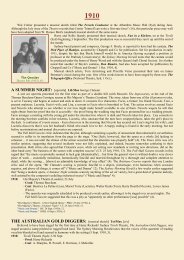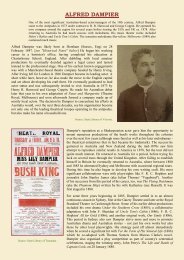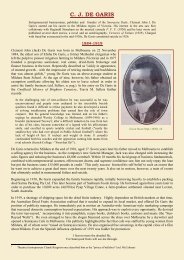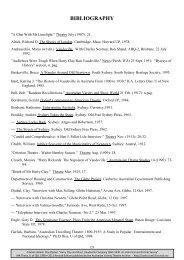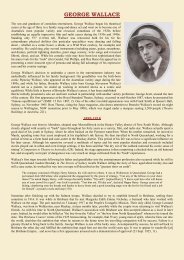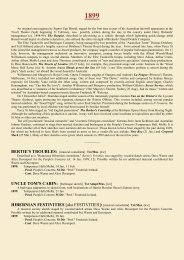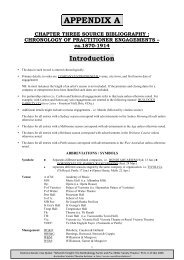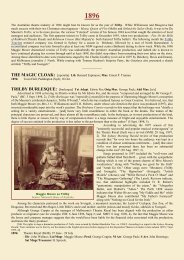1913 - Australian Variety Theatre Archive
1913 - Australian Variety Theatre Archive
1913 - Australian Variety Theatre Archive
You also want an ePaper? Increase the reach of your titles
YUMPU automatically turns print PDFs into web optimized ePapers that Google loves.
<strong>1913</strong><br />
IN SUNNY JAPAN: [musical scena] Txt/Mus. [n/e]<br />
Described described as a "sketch" and a "musical trifle' during the <strong>1913</strong> Perth season, and as a "musical comedietta" in<br />
several newspapers in 1914 (MDA: 20 Feb. 1914, 2), In Sunny Japan was reportedly based on or adapted from a similarly-named<br />
production which ran in London for "two successive season" (LE: 28 Jan. 1914, 2).<br />
The version produced by Edward Branscombe in 1915 saw In Sunny Japan described in a Brisbane Truth review as "easily<br />
the best thing yet seen from the Dandies… A miniature musical comedy… [in which] the talented artists proved their worth" (5<br />
Sept. 1915, 2). By 1918 the production was again being described as both a "picturesque musical sketch… introducing song,<br />
chorus, duets, quartette, sextette and dance" and an Oriental scena (BC: 12 Jan. 1918, 2). The 1918 version was one of several<br />
scenas staged in Brisbane during the year.<br />
The connection between all the various versions staged between <strong>1913</strong> and 1918 was the presence of Walter George and<br />
Georgie Martin, who brought the Smart Set to Australia under contract to J. and N. Tait in 1912. The two performers were later<br />
members of Edward Branscombe's Scarlet Dandies Company (TT: Jan. 1915, 47). While there were undoubtedly changes made to<br />
In Sunny Japan over the years - notably in the songs, comedy and dances - the narrative premise is believed to have remained<br />
largely the same.<br />
Mercury (Hobart) 11 May (1914), 6.<br />
[NB 1: The <strong>Australian</strong> public's interest in Oriental musical scenas is evidenced by the fact that a large number were produced around the country between the<br />
mid-1910s and early 1920s. Taking Brisbane as an example, Edward Branscombe's Dandies staged In China Town at the Cremorne Garden <strong>Theatre</strong> in 1917 (ca. 14<br />
Apr.); while John N. McCallum's Courtiers company presented a similar version of the same 'fascinating Chinese Scene' at the Cremorne in early September of the<br />
same year. A month later In Yokohama was staged by the Smart Set Entertainers (12 Oct.) at the Palace Gardens. Other oriental-influenced scenas staged in<br />
Brisbane during 1918 include: In Sunny Japan (Smart Set; 11 Jan.); several unnamed productions in early February and early March; In Fair Japan (20 Sept.) and<br />
Asia Minor (11 Oct.). Productions from 1919 included Huxham's Serenaders' The Fan Tan Man (10 Jan.)]<br />
[NB 2: It has been suggested that a number of these scenas might have been adapted or reinterpreted from other productions, including the use of scenic art<br />
and props. Delyse Ryan ("Brisbane <strong>Theatre</strong> During World War I"), for example, proposes that using set pieces from previous productions may have been a costsaving<br />
policy at Brisbane's Cremorne Garden <strong>Theatre</strong> (143). However as variety audiences expected a constant stream of new and stimulating entertainments,<br />
entrepreneurs like John N. McCallum would have restricted the reuse of sets to the revivals of popular productions rather rehashing old shows under new titles. It<br />
is also more likely that old scenic art was painted over to reduce production costs. It is also believed that redundant scenic art was sometimes sold to other<br />
organisations, theatrical or otherwise. In August 1916, for example, Brisbane's Glideway Skating Rink advertised the 'tremendous scenic production' In Sunny<br />
Japan. A similarly titled scena had been staged at the nearby Cremorne the previous year (ctd. BC: 5 Aug. 1916, 2)]<br />
<strong>1913</strong>: Follies <strong>Theatre</strong>, (St Kilda, Melbourne); 1 Mar. -<br />
- Dir. Walter George; Prod. J. and N. Tait.<br />
- Troupe: Smart Set Entertainers.<br />
- Cast incl. Walter George, Georgie Martin, Emily Kroll, Edward Elliot, Sunshine James, Mona Thomas, Tristram<br />
Greene.<br />
- Musician: Edgar Holland (piano).<br />
- First production in Melbourne.<br />
<strong>1913</strong>: Tivoli <strong>Theatre</strong> (Perth); 14 Apr. -<br />
- Dir. Walter George; Prod. J. and N. Tait.<br />
- Troupe: Smart Set Entertainers.<br />
- Cast and production mostly as for previous Melbourne season.<br />
1914: Town Hall, Hobart; 23-29 Jan. -<br />
- Troupe: Smart Set Entertainers.<br />
- Cast and production mostly as for previous seasons.<br />
- First production in Tasmania.<br />
1914: Academy of Music, (Launceston); 30 Jan. -<br />
- Troupe: Smart Set Entertainers.<br />
- Cast and production mostly as for previous seasons.
1914: Victorian regional tour; ca. Feb.<br />
- Troupe: Smart Set Entertainers.<br />
- Cast and production mostly as for previous seasons.<br />
- Tour incl. Ballarat (Masonic Hall; 16 Feb. -) • Marybough (Town Hall; 20 Feb.)<br />
1914: Athenaeum <strong>Theatre</strong> (Melb); 2-8 Mar.<br />
- Troupe: Smart Set Entertainers.<br />
1915: Queensland regional tour; ca. June/July<br />
- Dir. Edward Branscombe; Prod. Edward Branscombe and Birch<br />
and Carroll (incl. T.V. Coyle in Charters Towers).<br />
- Troupe: The Smart Set.<br />
- Itinerary incl. <strong>Theatre</strong> Royal, Charters Towers (28 June -)<br />
1915: Cremorne Garden <strong>Theatre</strong> (Bris); 4 Sept. -<br />
- Dir/Prod. Edward Branscombe.<br />
- Troupe: Edward Branscombe's Dandies.<br />
1918: Palace Gardens (Bris); 11-17 Jan.<br />
- Dir. Walter George; Mngr. Thomas J. Rayment.<br />
- Troupe: Smart Set.<br />
- Cast incl. Walter George, Georgie Martin, Les Coney, Harry de Robeck, Gwen Gaylor, Lalla Knight, Gordon Jago.<br />
- Musicians: Bijou Orchestra.<br />
"Cremorne <strong>Theatre</strong>." TBRS: 5 Sept. (1915), 2.<br />
"Entertianments: Smart Set, The." LE: 28 Jan. (1914), 2.<br />
"Smart Set, The." WA: 15 Apr. (<strong>1913</strong>), 7.<br />
"Town Hall, Tonight: The Smart Set." MDA: 20 Feb. (1914), 2.<br />
THE JAM OF CATHAY: [musical comedy] Txt/Orig. Mus. Harry Taylor; Add Mus [n/e]<br />
Described in New Zealand's Dominion newspaper in 1914 as a "musical extravaganza designed "to give ample scope for<br />
picturesque scenery, bright costumes and a succession of ballets," The Jam of Cathay is believed to have been first staged (under<br />
canvas) by Jasper's Pantomime Company in late <strong>1913</strong>. It was also toured throughout New Zealand the following year by the<br />
Stephenson and Linley Combination. Also known as The Humpty Dumpty Pantomime Company, the troupe comprised most of<br />
the same performers who had toured under Edward Jasper's management.<br />
The story revolves around the theft of the Jam of Cathay's famous pickle by restaurant owner, Frascati. Following his<br />
mysterious death a stranger, Bill Smith, comes to town and impersonates him. A number of hilarious situations arise when several<br />
other people arrive in town - these being Frascati's daughter Marie, the amorous military officer Hon. Bobby Atkins (who is trying<br />
to show how essential Marie is to his existence), the Jam of Cathay (very tall and fierce and in search of the pickle-recipe stealer),<br />
and his "chocolate -coloured" daughter, Marmalade (very short and plump). The pseudo Frascati saves himself for the jam's<br />
vengeance by making an alliance with the sweet Marmalade. In the meantime the Jam has decided to abduct Marie and add her to<br />
his harem. She is saved by Bobby, in the disguise of a corn doctor.<br />
The Nepean Times records that the production included all the latest songs<br />
and dances. Two songs known to have been incorporated into the show that<br />
year were "England and Ireland" and "Australia" (31 Jan. 1914, 4).<br />
A number of newspapers recorded that Taylor had sold the American and<br />
English rights (see for example C: 9 Jan. 1915, 7).<br />
[NB: The abbreviation JoC is used below to identiy known production dates. All<br />
other dates identify only the start and/or length of seasons (where known).<br />
<strong>1913</strong>: (Queanbeyan, NSW); 6 Oct. -<br />
- Prod. Edward Jasper; Adv Rep. Harry Barton<br />
- Troupe: Jasper's Pantomime Company.<br />
- Cast incl. Ted Stanley, Ida Ingersole, Charles Howard, Olive<br />
Robinson, Ailsa Sherbrook, H. Dickinson.<br />
- The company reportedly comprised 30 performers.<br />
- Tour also included Bluebeard.<br />
<strong>1913</strong>: Town Hall (Parramatta); 17-18 Oct.<br />
- Troupe: Jasper's pantomime Company.<br />
- Cast and production as for Queanbeyan season.<br />
<strong>1913</strong>: Opposite Couhlan's Store (Singleton); 13 Nov. -<br />
- Troupe: Jasper's Pantomime Company.<br />
- Cast and production as for Queanbeyan season.<br />
1914: Sydney suburban tour; ca. Jan. - Mar.<br />
- Troupe: Jasper's pantomime Company.<br />
- Cast incl. Con Moreni (Frascatti,), Ida Ingersole, Charles Howard,<br />
Olive Robinson, Ailsa Sherbrook, H. Dickinson.<br />
- Tour incl. Penrith (28 Jan. - )<br />
1914: (Queanbeyan, NSW); 31 Mar. -<br />
- Prod. Edward Jasper; Adv Rep. Jack Howard.<br />
- Troupe: Jasper's Pantomime Company.<br />
Queanbeyan Age 3 Oct. (<strong>1913</strong>), 3.
- Cast and production as for previous Sydney suburban tour.<br />
- 1914 tour incl. Bluebeard and The Great Ragtime Revue.<br />
1914: Market Square (Grafton, NSW); 5 May -<br />
- Troupe: Jasper's Pantomime Company.<br />
- Cast and production as for previous Sydney suburban tour.<br />
1914: McCardell's Paddock (Wangaratta, Vic); 15 Sept. -<br />
- Prod. Edward Jasper; Adv Rep. Jack Howard.<br />
- Troupe: Jasper's Pantomime Company.<br />
- Cast incl. Con Moreni (Frascatti,), Ida Ingersole, Charles Howard, Olive Robinson, Ailsa Sherbrook, H.<br />
Dickinson, Ernest Lashbrook, Stella Cazalla, Mollie King, Gloria Gould.<br />
- By September the tour repertoire also included Humpty Dumpty.<br />
1914: New Zealand Dominion tour; ca. Nov-Dec.<br />
- Prod. George Stephenson and Alf Linley; M Dir. Harry Taylor.<br />
- Troupe: Stephenson and Linley Combination (aka Humpty Dumpty Pantomime Company)<br />
- Cast incl. Con Moreni (Frascatti,), Ida Ingersole (Alphonse), Charles Howard (The Jam), Olive Robinson<br />
(Marmalade), Elsie Nicolas (Marie), Ernest Lashbrook (Hon. Bobby Atkins), Mollie King (Babette), lennon,<br />
Hymen and Lennon, The Three Rubes.<br />
- Tour incl. Wellington (Grand Op House; 21 Nov. - ) • Lyttelton (Th Royal; 28 Nov. - 3 Dec. > JoC 2-3 Dec.) •<br />
Ashburton (Th Royal; 23 Dec. - ) • Greymouth (30 Dec.)<br />
1915: New Zealand Dominion tour; 1 Jan. - ca. Feb/Mar.<br />
- Prod. George Stephenson and Alf Linley; M Dir. Harry Taylor.<br />
- Troupe: Stephenson and Linley Combination (aka Humpty Dumpty Pantomime Company)<br />
- Cast and productions as for 1914 Dominion tour.<br />
- Tour incl. Greymouth (1-6 Jan. > JoC 2-4 Jan.) • Nelson (Th Royal; 13-15 Jan. > JoC 15 Jan.) • Blenheim (His<br />
Majesty's; 18-20 Jan. > JoC 20 Jan.) • Gisborne (Op House; 6 Feb. - ) • Wanganui (Op House; 18-20 Feb. > JoC<br />
20 Feb.)<br />
"Entertainments: The Jam of Cathay." DNZ: 21 Nov. (1914), 10.<br />
"Jam of Cathay: The Stephenson-Linley Company, The." DNZ: 23 Nov. (1914), 7.<br />
"Jasper's Pantomime Co." QA: 3 Oct. (<strong>1913</strong>), 2.<br />
"Jasper's Pantomime Co." NT: 31 Jan. (1914), 4.<br />
"Jasper's Pantomime Co." CRE: 30 Apr. (1914), 8.<br />
COME OVER HERE: [revue] Txt Adapt Frank Dix; Mus incl. Andrew MacCunn and Emil Bierman<br />
Australia's first-ever revue, Come Over Here was adapted for local audiences by<br />
Frank Dix and his production from the original by Max Pemberton and W. Mizner,<br />
with the intent being to present a satirical and topical entertainment spectacular based<br />
on the popular culture theatre trend currently finding appeal in America, Britain and<br />
Europe, but which had social relevance to <strong>Australian</strong>s. The Sydney Morning Herald<br />
notes in this regard: "[The] elements of gaiety form the dominating constituents of<br />
Come Over Here. This Parisian manner of glancing at the current events of life's<br />
passing show, now first brought forward in Australia by the J. C. Williamson<br />
direction, closely resembles a variety entertainment which becomes less account than<br />
the magnificence of its background. Remodelled to local conditions by Mr Frank Dix,<br />
the revue was practically a new piece" (22 Dec. <strong>1913</strong>, 3). Further localisation was also<br />
specifically incorporated into the Sydney and Melbourne seasons. The Sydney season,<br />
for example, saw scenic artist W. Little illustrate a number of local settings (set<br />
variously in the past, present and future), including : "The Farmers' Roof Garden"<br />
(with glimpses of Her Majesty's <strong>Theatre</strong>, St Mary's Cathedral and other familiar<br />
objects); "A Venetian Fete at Manly in 1999"; "The Aboriginals" (which presented a<br />
view of Circular Quay in its virgin state in 1700); "The First Settlers" (1801); "The<br />
Gold Rush" (1849); and the vestibule of the Hotel Australia, followed by a view of the<br />
Winter Garden, looking stately in festival array. For the 1914 Melbourne production<br />
some of these scenes were changed to incorporate Victorian settings. One notable<br />
change was the "Venetian Fete," which became "Henley-on-Yarra in 1999." A scene<br />
from Flemington ("Under the Elms") was also presented, with performers<br />
impersonating well-known figures from the state. Other local settings were: scenes of<br />
Collins Street (in 1830, 1857 and 1914); the Melbourne Exhibition of 1880; "The<br />
Birth of Melbourne" (set to music especially composed by Andrew MacCunn), Yarra<br />
Bend Station and Kosciusko (ARG: 30 Mar. 1914, 13).<br />
Source: State Library of NSW<br />
While the revue's objective was to target high profile <strong>Australian</strong> personalities, the Sydney debut found itself heavily<br />
criticised for being out of date. Hits at former Prime Minister George Reid (1904-05) were presented as examples of this. In one<br />
prominent scene, too, ex-NSW premiers C. G. Wade (1907-10) and the recently deposed James McGowan (1910-<strong>1913</strong>),
impersonated by Fred Leslie and Jack Cannot respectively, waged a heated dispute following a motor car accident. The Bulletin<br />
also took a swipe at those responsible, proposing that they seemed to be under the delusion that McGowan was still Premier.<br />
The Sydney Morning Herald notes, however, that the same scene had some merit. "Little Australia, a part cleverly played by<br />
Gertrude Cremar," writes the paper's critic, "slipped in between the disputants and exclaimed, "When you've done calling each<br />
other names, perhaps you'll do something for me!" This was one of the most appreciated points in the dialogue, newly localised<br />
and brought up to date by Mr Dix." Stung by the criticism Dix quickly introduced more topical matter. By the time the production<br />
premiered in Melbourne hits at the current Prime Minister and leader of the opposition were being featured.<br />
A good deal of ragtime music was introduced into the revue, in addition to<br />
arias from recent operas and music to accompany current dance crazes like the<br />
Tango. Specialist dancers Fred Leslie and Ivy Shilling also staged their<br />
'movement spectacular' called "The Spider's Web." This act saw Shilling<br />
(representing a butterfly) trapped in a "colossal circle of gossamer threads" while<br />
Leslie, as the arachnid, circled menacingly (in later years the same act was<br />
reinterpreted in Australia by such performers as contortionist Hector "The<br />
Human Spider" Napier and dancer Robert Helpmann). Among the revue's<br />
biggest musical hits were the songs performed by comedians Daisy Jerome and<br />
Jack Cannot. Jerome's specialties included: "The Press, the Pulpit and the<br />
Petticoat," "Smart, Smart, Smart," "Do they all go out to see the Sea," "Popsy<br />
was a Singer" and "Row, Row, Row." Cannot, who "seemed to be on the stage<br />
all evening" found much success with 'The German Band'.<br />
Although Come Over Here was well received by audiences and attained<br />
much commercial success, it divided the critics into those who saw a missed<br />
opportunity to make overt social comment and those whose interest lay primarily<br />
in the aspects of spectacle and entertainment. Critics from the first camp were<br />
nevertheless impressed with the overall production values. Reviewing the<br />
Sydney premiere in <strong>1913</strong>, for example, The Bulletin's "Sundry Shows" editor<br />
wrote: "Australia saw its first revue... on Saturday night. As a spectacle the new<br />
show is exquisite; it is the biggest, the most picturesque and probably the most<br />
Source: National Library of Australia<br />
costly thing on pantomime lines that has been done in Australia. The two chief<br />
sensations - a race between a motor car and a train, and the apparent drowning of<br />
a herd of show girls at manly - are highly ingenious, though they are not in the least convincing... Where Come Over Here fails<br />
miserably [however] is in its fugitive and halting efforts to review current happenings in a lightsome spirit" (25 Dec. <strong>1913</strong>, 8). The<br />
Sydney Morning Herald critic agreed in part, proposing that the first half of the programme 'was so inherently dull, so lacking in<br />
the "bite" and "sting" which pre-eminent talent might have given it, that an alteration to "Stay Over There" might have suggested<br />
itself to the audience had not the whole show got a move on in the second act... [then] all went merry as a marriage bell and the<br />
graceful ballets, the novel scenic schemes that surprised and enchanted the eye with their glow of colour and the costly gowning<br />
of shapely girls in illustration of the ultimate extravagance of the fashions of the day, were recognized in overwhelming bursts of<br />
applause' (22 Dec. <strong>1913</strong>, 3).<br />
Daisy Jerome and Jack Cannot established hugely successful careers in Australia in the wake of Come Over Here.<br />
Commonly referred to as 'the electric spark', Jerome toured Australia twice (<strong>1913</strong>-1916 and 1920-1922), becoming the second<br />
highest paid female variety artist ever contracted to Fullers <strong>Theatre</strong>s. Cannot remained more or less permanently in the country<br />
performing for most leading variety companies, notably the Tivoli circuit, until his death in Sydney from suicide in 1929.<br />
Jack Cannot<br />
<strong>Theatre</strong> July (1915), 37.<br />
Fred Leslie and Ivy Schilling<br />
Source: National Portrait Gallery (no date)<br />
Daisy Jerome<br />
Couresty of Veronica Kelly (no date)<br />
[NB: Come Over Here's British debut at the London Opera House was on 19 April <strong>1913</strong>. The original music was by Louis A. Hirsh and J. Rosamond Johns.<br />
Additional material interpolated into the revue included songs by Irving Berlin and Harry Von Tilzer among others.
<strong>1913</strong>: Her Majesty's <strong>Theatre</strong> (Syd); 20 Dec. <strong>1913</strong> - 24 Mar. 1914<br />
- Dir. Frank Dix (with Oscar O'Dec); Prod. J. C. Williamson's Ltd; M Dir. Emil Bierman; Chor. Minnie Hooper;<br />
S Art W. Little.<br />
- Cast incl. Jack Cannot, Daisy Jerome, Fred Leslie, Ivy Shilling, Winnie Volt, Olive Goodwin, Leslie Holland, John<br />
Osborne, Charles Stone, Edmund Sherras, Violet Collinson; Chorus: Nance Anderson, Tina Breon.<br />
- A number of performers are mentioned in reviews for the following Melbourne season and may also have been<br />
involved with the Sydney season (see below).<br />
1914: Her Majesty's <strong>Theatre</strong> (Melb); 27 Mar. - 28 May<br />
- Cast and production mostly as for previous Sydney season. Performers identified in reviews of the Melbourne season<br />
are: Ruby Armfield, Claude Bantock, Lillie Leslie, Dolly Nepean, Jennie Keith, Madge Elliot, Louis Victor, Jack<br />
Hooker.<br />
"Come Over Here: Australia's First Revue." SMH: 22 Dec. (<strong>1913</strong>), 3.<br />
"From a First Nighter." B: 1 Jan. (1914), 8.<br />
"Her Majesty's <strong>Theatre</strong>." SMH: 20 Dec. (<strong>1913</strong>), 22.<br />
"Her Majesty's <strong>Theatre</strong> - Come Over Here." ARG: 30 Mar. (1914), 13.<br />
"Last Night of the Revue." SMH: 21 Mar. (1914), 24.<br />
"Sundry Shows." B: 25 Dec. (<strong>1913</strong>), 8.<br />
--- B: 2 Apr. (1914), 9.<br />
--- B: 9 Apr. (1914), 9.<br />
ALADDIN: [pantomime] Lib. Lester Brown et al; Mus incl. F. Wynne Jones<br />
While the authorship of this pantomime has not been established, there is no indication yet that the libretto was of overseas<br />
origins. The Sydney Morning Herald critic, in noting that Aladdin "had only been staged [in Sydney] twice before during the past<br />
15 years," suggests that while the librettist has followed the original [story] with as much fidelity as a modern burlesque will<br />
admit of… the book is far from strong" (SMH: 25 Dec. <strong>1913</strong>, 3). Willoughby engaged New York director, Lester Brown, to<br />
oversea the production. While Brown no doubt had some input into the libretto there is no indication as to whether he was entirely<br />
responsible for its construction. Brown was to remain in the country as a director/producer for a number of years. One of the<br />
highlights of the production was apparently Brown's "brilliant" Act 1 closure, the "Grand Ragtime Review."<br />
The Adelphi platform over the stalls runs the entire length of the theatre, and is lined throughout with a double row of glowing<br />
red lights, so that when the auditorium is in darkness the dancers who promenade along it can be readily viewed. Miss Nellie<br />
Marlowe was the principal ragtime singer and dancer, in association with Mr Henry Marceyl, and after both had reached the<br />
main stage again, amidst applause, the entire company cam back from the footlights and disappeared behind the front scene.<br />
This being immediately raised, a semi-circle of 16 tambos, with the various characters in the burlesque, and the chorus in<br />
raised tiers behind was picturesquely discovered, and the ragtime programme was concluded, with a reinforced ensemble<br />
(SMH: 25 Dec. <strong>1913</strong>, 3).<br />
Songs known to have been incorporated into the story are: "The Trail of the Lonesome Pine" and "Moon Song" (sung by<br />
Carrie Moore), "Whistle It" (Grace Palotta) and "Heart that's Free" (Mabel Batchelor).<br />
<strong>1913</strong>: Adelphi <strong>Theatre</strong> (Syd); 24 Dec. <strong>1913</strong> - 12 Feb. 1914<br />
- Dir. Lester Brown; Prod/Lse. George Willougby; Mus Arr/Dir. F. Wynne Jones; S Art. J. S. Mann.<br />
- Cast incl. Carrie Moore (Aladdin), Grace Palotta (Ko Ko, Captain of the Guard), Mabel Batchelor (Princess<br />
Badroulbadour), Ernest Pitcher (Emperor of China), Driscoll Brothers (Chinese Policemen), Percy Clifton (Abonazar),<br />
Beret Barton (Vizier), Edward Stanley (Widow Twankey), J. P. O'Neill (Biddy, a suffragette), Ruby Davies (Ah Sing),<br />
Nellie Marlowe, Henry Marceyl, Joe Morris, Ernest Shand, Leon Morris's Ponies, John Hedge, Valentine and Bell,<br />
Tiny Tot Marjorie.<br />
"Aladdin: The Adelphi Pantomime." SMH: 25 Dec. (<strong>1913</strong>), 8.<br />
* HEY DIDDLE DIDDLE AND THE MAN IN THE MOON: [pantomime] Lib/Mus [n/e].<br />
Almost nothing is currently known about this supposed Stanley McKayproduced<br />
pantomime. The first record of its existence found to date is a <strong>1913</strong><br />
advertisement in the Clarence and Richmond Examiner publicising a<br />
forthcoming season in Grafton during the town's Race Week (3 July <strong>1913</strong>, 1).<br />
Later that same year New Zealand's Truth newspaper reported that Hey<br />
Diddle Diddle was one of three pantomimes to be shortly toured around the<br />
Dominion by Stephenson and Linley in association with McKay - the other<br />
works being Little Bo-Peep and Old Mother Hubbard (11 October <strong>1913</strong>, 2).<br />
No reviews or confirmed dates have yet been located for either the <strong>Australian</strong><br />
or New Zealand tours of <strong>1913</strong> and 1914. This suggests that it was either<br />
relegated to a back-up production, or possibly never even produced.<br />
Clarence and Richmond Examiner 3 July (<strong>1913</strong>), 1
* PUSS IN BOOTS: [pantomime] Lib/Mus [n/e].<br />
In <strong>1913</strong>, around the same time that he was preparing to open his Bridge <strong>Theatre</strong> in Newtown (Sydney), Harry Clay sent a 26<br />
member pantomime company on tour through Northern New South Wales. While many of the details regarding the tour are<br />
currently unknown, including which towns comprised the itinerary and how long the tour lasted, the Clarence and Richmond<br />
Examiner records that the feature production had been named as Puss in Boots, supported by Cinderella. The same article also<br />
notes that the troupe, billed as the Royal pantomime Company, had recently finished a tour of Victoria, while advertising indicates<br />
that Puss in Boots was being produced in Grafton as its season in Sydney. While it is unclear if the Victorian or Sydney ventures<br />
were toured under the auspices of Clay or someone else, it is unlikely that Clay's production of Bo-Peep was in any way<br />
associated with the J.C. Williamson pantomime staged in Sydney between March and May <strong>1913</strong>.<br />
The principal cast members mentioned in the preview also indicates that it<br />
was not the Royal Pantomime Company then being toured by Stanley McKay<br />
around Australia (and which opened in New Zealand later in the year).<br />
As to the work itself, all that is known is that it was staged over two acts<br />
and 12 scenes.<br />
<strong>1913</strong>: Rink Hall, Grafton (NSW); 16 July - (first established production)<br />
- Prod. Harry Clay; S Art. Harry Grist.<br />
- Troupe: Royal Pantomime Company<br />
- Cast incl. J.J. Lanphier, Reg Hughes, Murray Ross, Iris Webster,<br />
Dulcie Scott, Daisy Leonard.<br />
- As noted above Puss in Boots was very likely toured through<br />
Victoria and possibly other towns in NSW prior to the July<strong>1913</strong><br />
Grafton season. Its debut may also have been as early as 1912.<br />
Clarence and Richmond Examiner<br />
15 July (<strong>1913</strong>), 1.<br />
* CINDERELLA: [pantomime] Lib/Mus [n/e].<br />
In <strong>1913</strong>, around the same time that he was preparing to open his Bridge <strong>Theatre</strong> in Newtown (Sydney), Harry Clay sent a<br />
pantomime company on tour through Northern New South Wales. While many of the details regarding the tour are currently<br />
unknown, including which towns comprised the itinerary and how long the tour lasted, the Clarence and Richmond Examiner<br />
records that the feature production had been named as Puss in Boots, supported by Cinderella. The same article also notes that the<br />
troupe, billed as the Royal pantomime Company, had recently finished a tour of Victoria. It is unclear if either the Victorian or<br />
Sydney ventures were toured under the auspices of Clay or someone else.<br />
The principal cast members mentioned in the preview also indicates that it was not the Royal Pantomime Company then<br />
being toured by Stanley McKay around Australia (and which opened in New Zealand later in the year). The company also<br />
reportedly comprised 26 artists.<br />
<strong>1913</strong>: Rink Hall, Grafton (NSW); 16 July - (first established production)<br />
- Prod. Harry Clay; S Art. Harry Grist.<br />
- Troupe: Royal Pantomime Company<br />
- Cast incl. J.J. Lanphier, Reg Hughes, Murray Ross, Iris Webster, Dulcie Scott, Daisy Leonard.<br />
Last updated: 18/11/2012<br />
Expanded and updated from Clay Djubal, "What Oh Tonight" (Appendix C), Ph D Diss (2005) U of Qld.<br />
NB: The URL for this PDF will change each time it is updated. If you wish to cite or link to this record please use the following:<br />
<strong>Australian</strong> <strong>Variety</strong> <strong>Theatre</strong> <strong>Archive</strong> • http://ozvta.com/1910s/




